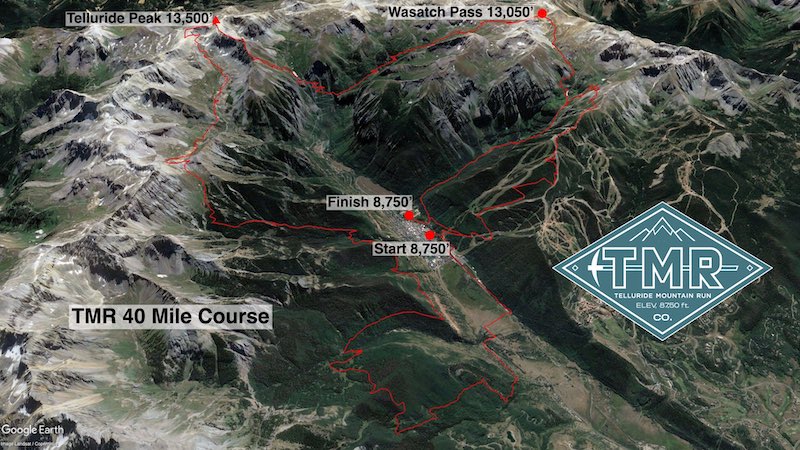 The 40-mile Telluride Mountain Run loops around the town’s box canyon to capture one of the steepest, most scenic routes possible around Telluride. I’ve tackled the race in three different years (2016, 2018 and 2021), and each time, the race director has altered the course to make it more difficult.
The 40-mile Telluride Mountain Run loops around the town’s box canyon to capture one of the steepest, most scenic routes possible around Telluride. I’ve tackled the race in three different years (2016, 2018 and 2021), and each time, the race director has altered the course to make it more difficult.
This year’s edition, held a week ago on August 28, ascended over 14,000 feet total at high altitude and added a bonus mile-plus, so it measured almost 42 miles. Moreover, the route changed its final climb in the last 10 miles to go up roughly twice as high as the final hill in prior years.
This make-or-break segment of the course after mile 30 broke several runners, but didn’t stop me.
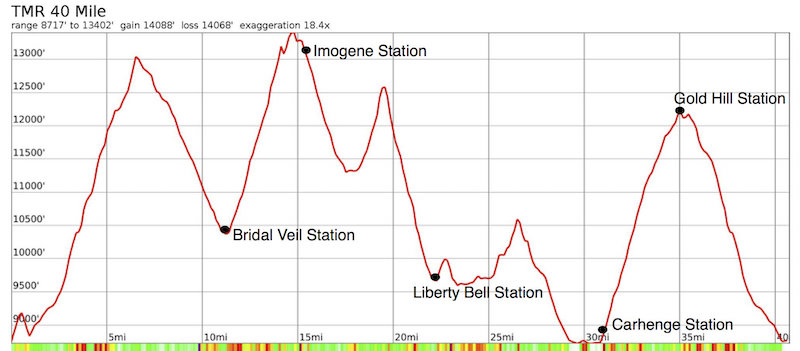
The reckoning came at mile 31 at the town’s public parking lot called Carhenge, next to the base of a ski slope. A sign on the aid station’s pop-up tent had humorously and appropriately crossed out “Carhenge” and written next to it, “Carnage.” Several overheated, exhausted runners sat in the tent’s shade, shaking their heads and blinking, as if disbelieving we had to go up another 3500 feet in the next five miles to summit another mountain.
We had been going for over 10 hours—a ridiculously slow pace for a 50K. We had run the downhills and flatter segments as best as we could, yet we only managed to average around 3 miles per hour, a walking pace, because so many uphill miles slowed to a crawl up the sides of mountains and along a loose-rock fin of a ridge above 13,000 feet elevation.
I had parked my car 50 feet from this aid station. It would have been so easy to drop out then and there, calling it a day three-quarters of the way through. Instead, in between bites of watermelon, I told two guys slumped in chairs with whom I’d been leapfrogging, “This is not a 50K, you can’t stop here, let’s get going!”
They kept sitting, I got going.
I felt a burning determination to finish this course, partly because I was the only over-50 woman entered, so I felt I had to prove to others and to myself that I could finish among so many younger athletes.
But the thing was, I actually wanted to get up and over that last climb. Where did this desire come from; why put myself through this?
I pondered the reasons while hiking up to the top of a ski slope called See Forever, where you can see the summits that define the Telluride Mountain Run and the more famous Hardrock 100. Part of my drive felt almost territorial. I’m a local, I thought, and I belong here. I love these mountains, I want to traverse them and feel as if I’m a part of them.
The drive also comes from the paradox of ultrarunning: the more I wear myself out, the more powerful I feel during and after. Each upward step on each switchback felt arduous but satisfying, knowing I would complete this course in a not-too-shabby time. Race day gives us the opportunity to test ourselves in ways we’re not likely replicate on a training day, and I didn’t want to miss that opportunity.
Mostly, I felt heartened and relieved because my body could handle this, just four weeks after finishing the depleting High Lonesome 100. My summer training had been focused on High Lonesome. (I wrote a race report about High Lonesome for UltraRunning if you want to read the details.) After a week of rest, I was pleasantly surprised my legs felt springy and strong. High Lonesome gave me a fitness boost, and I decided to leverage it at this race.
I also felt relieved—and proud—that I had survived the midway crux of the race: a 1.5-mile rocky ridge line leading up and over the 13,500-foot Telluride Peak. When I first traversed this ridge in the 2018 edition of the race, I had tensed with fear when glimpsing the steep drop-offs on either side. I had felt unsafe and unprepared up there three years ago, with my hands clutching at rock while my legs trembled.
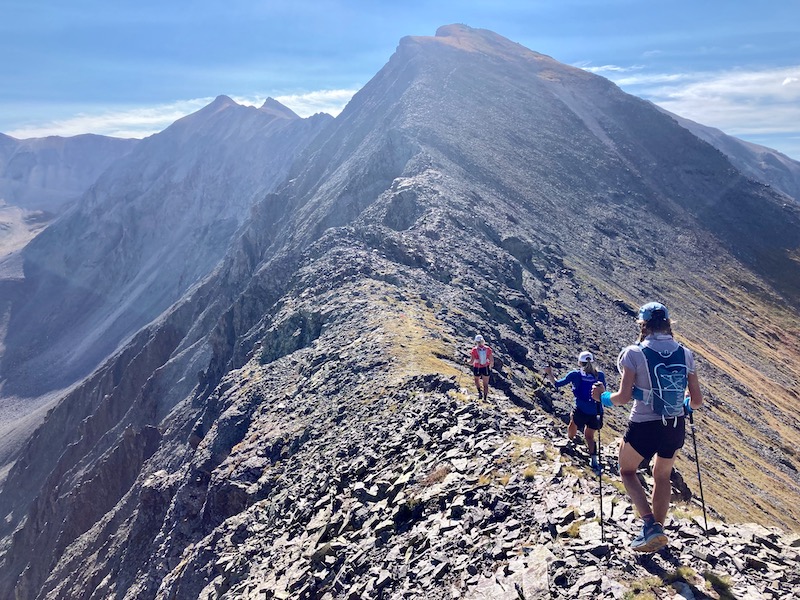
The guy behind me, Willie McBride, took this pic of my back around mile 14 as we embarked on the ridge toward Telluride Peak in the distance. Anna Frost is two ahead in the red. The route followed the ridge for 1.5 miles all the way to the left where it met Imogene Pass.
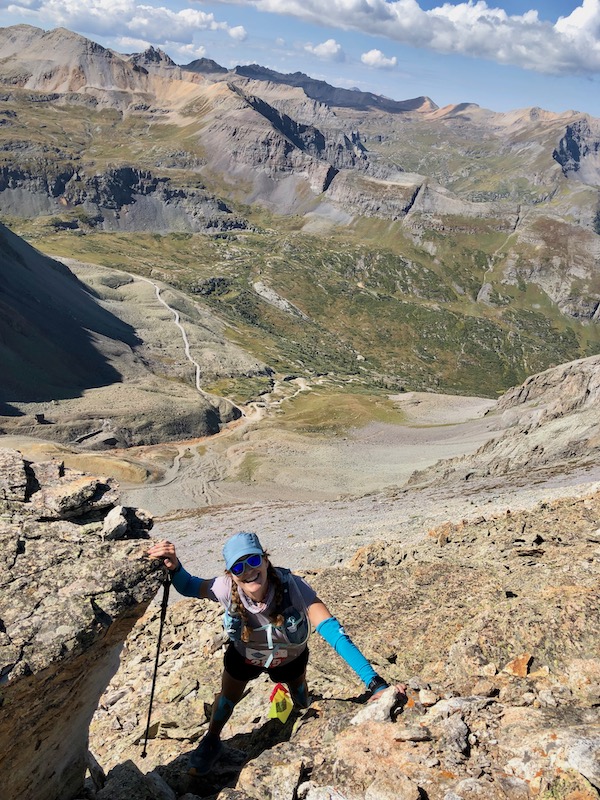
This is one of several sections of the ridge where I had to use my hands to claw my way up. Photo by local runner Sheamus Croke who was up there volunteering as a safety monitor (thank you!). It took me 42 minutes to go one mile along here.
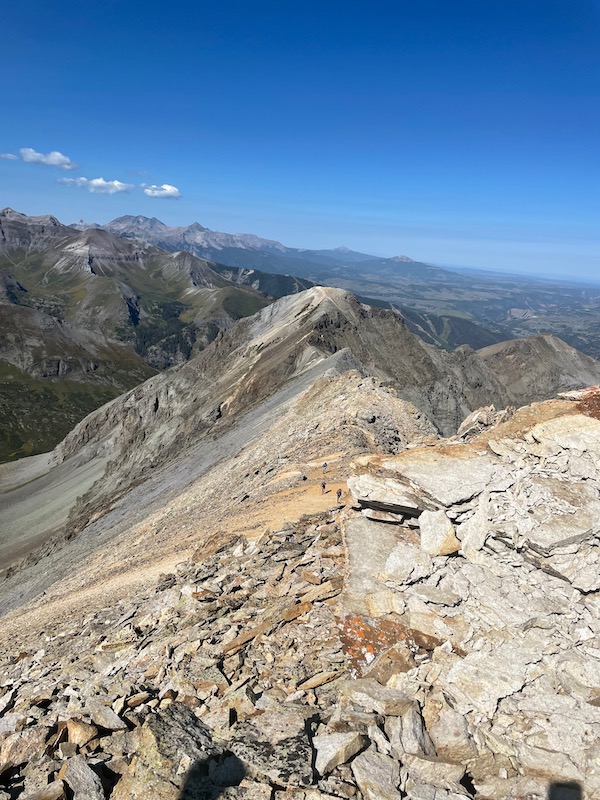
Another nice shot of the ridge, from the summit of Telluride Peak looking west back at the way we came, with Wilson Peak way in the distance. Photo by Willie McBride.
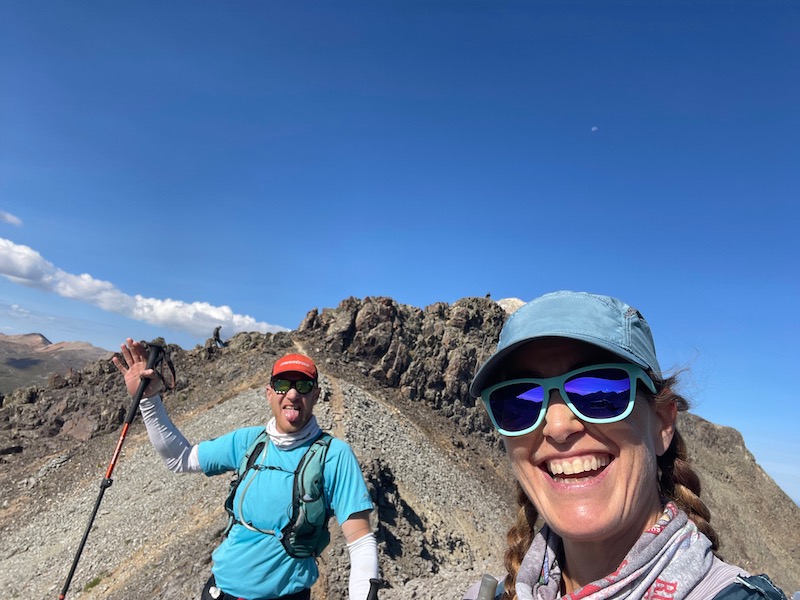
This is the guy who was behind me taking photos. Thank you, Willie!
This year, however, I demystified that stretch by practicing it earlier in the week with two younger women, Whiley Hall and Maria Sylte, who are highly experienced at climbing and bagging 13’ers. They kindly showed me the way. Thanks to them and our training run, I methodically moved across the ridge with confidence, barely fazed by the drop-offs and with only a fraction of the fear I felt the first time.
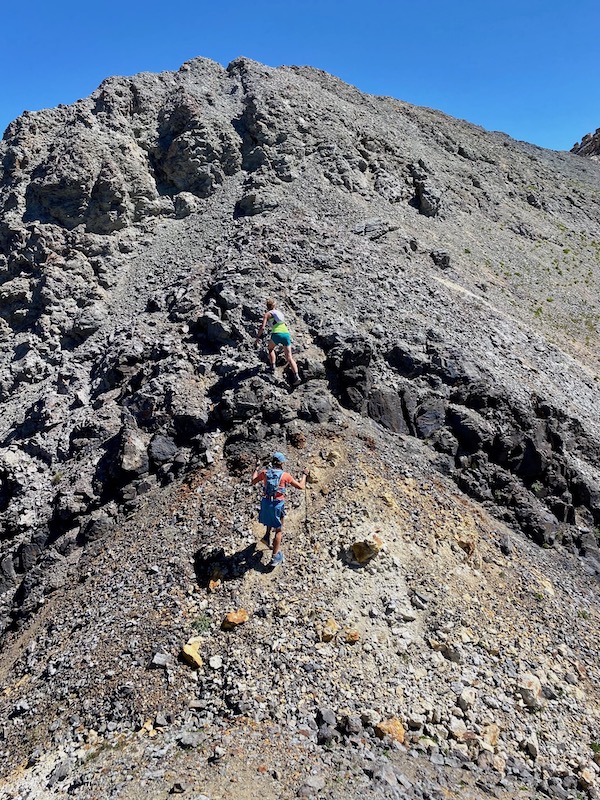
This is a shot of our training run earlier in the week, showing the steepness of parts of the ascent. I’m following Maria Sylte; photo by Whiley Hall.
As always, the other runners helped me do more than I likely could or would on my own. I connected with whomever happened to be nearby. I didn’t recognize many of them, except for a handful locals, and I was convinced nobody knew me. Then a guy behind me said, “Are you Sarah?” and said he knew me because I was “OG.” I didn’t know if he meant Old Guard or Original Gangster, but I took it as a compliment.
One man flew by on the downhill from Imogene Pass to Marshall Basin, his bib revealing he was in the event’s shorter 24-mile division, and I thought he must be an elite-level runner trying to catch up to the front of the pack. Then a couple of miles later, going up a slope so steep that my pace slowed to about 30 minutes per mile, I found him sitting on a rock amidst the alpine tundra with his head in his hands. “Cannot breathe, cannot do uphill,” he said with a Spanish accent. I asked where he’s from, and he said Bolivia originally, but now he lives near sea level in Ojai, California. “No way!” I said. That’s my original hometown. I got him to start moving uphill to the 12,500-foot-high pass, and we chatted about all the trails we mutually know and love around the Ojai Valley.
The highlight of my socializing mid-race involved a meetup with Anna Frost, 39, the top ultrarunner from New Zealand whose career I’ve followed since 2010 when she won the North Face Endurance Challenge 50 two years in a row. We’ve met off and on over the years. She was in the 24-mile race, which started a half-hour after our 40-mile division, and she caught up to me on the switchbacks leading up toward Ajax Peak and the frightening rocky ridge line.
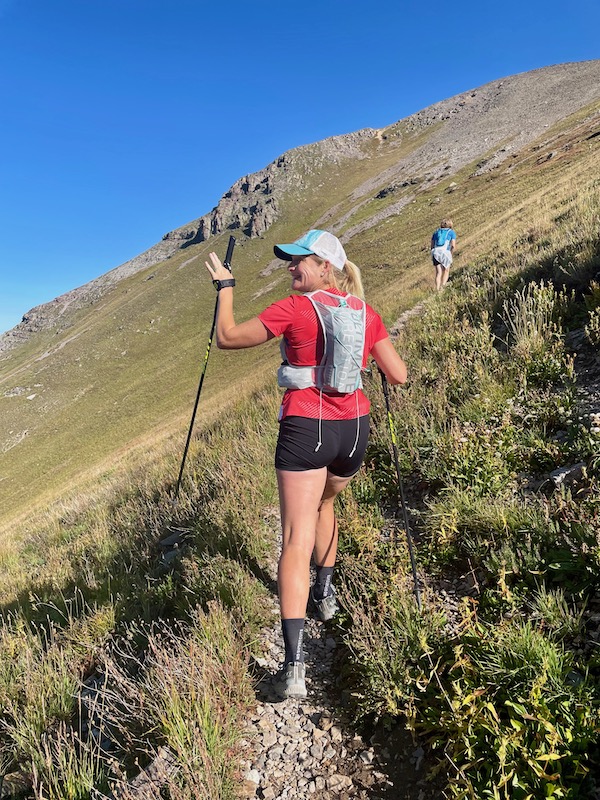
Following Anna Frost up the switchbacks.
“Anna, I’m glad to see you!” I called out on a switchback, stepping aside so she could get in front, and then I fell into step behind her. We started chatting about her 2-year-old daughter, about New Zealand and about the course. “They just keep going, don’t they?” she said of the switchbacks, sounding a bit fatigued, and then she complimented me, “You’re moving really well.” (Perhaps she was surprised I could keep up?) A guy ahead of us let us pass, and when he asked, “How are you doing?” I said, “I feel like I’m being paced by Anna Frost, so I’m freakin’ awesome!”
Of course, she dropped me on the technical downhill terrain, but I enjoyed reconnecting with someone else who has been in the sport for nearly two decades and has so much cred, and who is genuinely nice and humble.
After summiting the final climb and descending down toward town, my ankles, knees and lower back started protesting. I had fallen and rolled my left ankle around mile 25, and it “talked to me” the rest of the run. As much as I try to run downhill with a light footstrike and smooth flow, I still stiffen and struggle, planting my trekking poles like ski poles to reduce the impact on my lower body. Whatever, it ain’t pretty, but it works and gets me down the mountains.
I finished solidly midpack, 7th out of the 12 women who finished, and the six ahead of me were all under 30—I’m old enough to be their mother! I was 32nd overall out of the 74 who started (48 finished, 26 DNF’ed, full results here).
Earlier in the year, during the lackluster 100-miler I ran in January and the 50K in March, I felt dragged down by ambivalence and indifference toward ultrarunning. I was going through the motions, training and racing more out of a 26-year habit than true desire.
At the High Lonesome 100 and again at the Telluride Mountain Run, I welcomed the feeling of determination. Fatigued, I nonetheless had moments of true fun. I told myself, “I still got it. There’s still hope.”
***
Bonus: Book Recommendations
I read several good books this summer (see the sidebar on my blog, “My Bookshelf,” for links to some of them). For health and wellness, I recommend Keep Sharp and Exercised. If you are looking for mountain/ultra/trail how-to and inspiration, for you or a friend, please consider my book! Send me a message if you’d like to buy a personalized signed copy of The Trail Runner’s Companion.

Thank you for this! Congratulations on your strong finish and positive attitude. You may be in your 50s, but you’re still a lot tougher than many of the younger runners out there, male or female. My new race rule is: if another woman passes me and she looks young enough to be my daughter, I won’t try to keep up. I am just happy to still be out there in those mountains. My friend Julie, who is 77, puts it this way: getting older sucks, but it beats the alternative.
Well Done Sarah!
Great to read that your internal smile for running Ultras is peeking through again.
As always, your big events and writing so inspires my smaller, shorter efforts.
And – as an over 50 runner, my favorite part of this recap –
“….I felt a burning determination to finish this course, partly because I was the only over-50 woman entered….”
I fully understand that completely and use it as motivation too. Go OG runners!
Steve